It’s easier to love Apollo 11 if you were around to see it happen. For those who didn’t camp along the Cape Kennedy causeway to watch the Saturn 5 liftoff on July 16, 1969, or huddle around a rabbit-ear TV to watch Neil Armstrong climb down the ladder and walk on the surface of the moon four days later, it’ll always have a whiff of cable-channel documentary. And yet it doesn’t for Elon Musk.
Musk was born in 1971, in Pretoria, South Africa, two years after the Apollo 11 landing and half a world away from the country that achieved the great lunar feat. But somehow, he absorbed the primal power of the thing he was not there to see happen. “Apollo 11 was one of the most inspiring things in all of human history,” he said in a July 12 interview at the Hawthorne, Calif., headquarters of SpaceX, the rocket company he founded in 2002 that has since become its own icon of space exploration. “I’m not sure SpaceX would exist if not for Apollo 11.”
Today, SpaceX is one of a handful of powerful players—starry-eyed billionaires and the world’s two richest countries—competing in a race to set up shop on the moon. In the 1960s, it was a two-party sprint between the U.S. and the Soviet Union to be the first to get boots on the lunar surface, but this time around the U.S. finds itself in a bigger, multifront competition with private companies like SpaceX and Jeff Bezos’ Blue Origin and international powers, most critically China.

Like the Soviet Union and the U.S. during the Cold War, Beijing is using its space ambitions as a powerful ideological—and even expansionist—tool of statecraft. In January, China successfully landed Chang’e-4, a small base station and rover, on the far side of the moon, becoming the first nation to touch down in that unseen hemisphere. “We are building China into a space giant,” Chang’e-4 chief designer Wu Weiren said at the time.
Last year, Ye Peijian, the leader of the country’s lunar program, described the agency’s work by invoking Beijing’s growing dominance across the South China Sea islands: “The universe is an ocean, the moon is the Diaoyu Islands, Mars is Huangyan Island. If we don’t go there now, even though we’re capable of doing so, then we will be blamed by our descendants.” That may just be celestial saber rattling, but it’s gotten the attention of Western observers. “I have no doubt that within the next five years, they will complete [their own space station] and announce a manned lunar program,” says Joan Johnson-Freese, a professor of national–security affairs with expertise in space, science and technology at the Naval War College in Newport, R.I.
Read more: Welcome to TIME Immersive’s Apollo 11 Landing on the Moon experience
Driving the new space race is a potent mix of economic, technological and geopolitical imperatives. There are possible fortunes to be made from lunar ventures. Space-based businesses currently contribute $350 billion to global gross domestic product, a figure projected to jump to $1.4 trillion by 2040, according to Morgan Stanley. The moon could become a first outpost in efforts to colonize and exploit space. Just one example: there’s intense speculation about the fortune to be made from mining the moon for rare-earth metals used in electronics manufacturing. With current spacecraft tech, that fortune is canceled out fast by the billions of dollars it would cost to ship goods between Earth and the moon, but technology changes, and no one wants to be left out of a potential lunar gold rush.
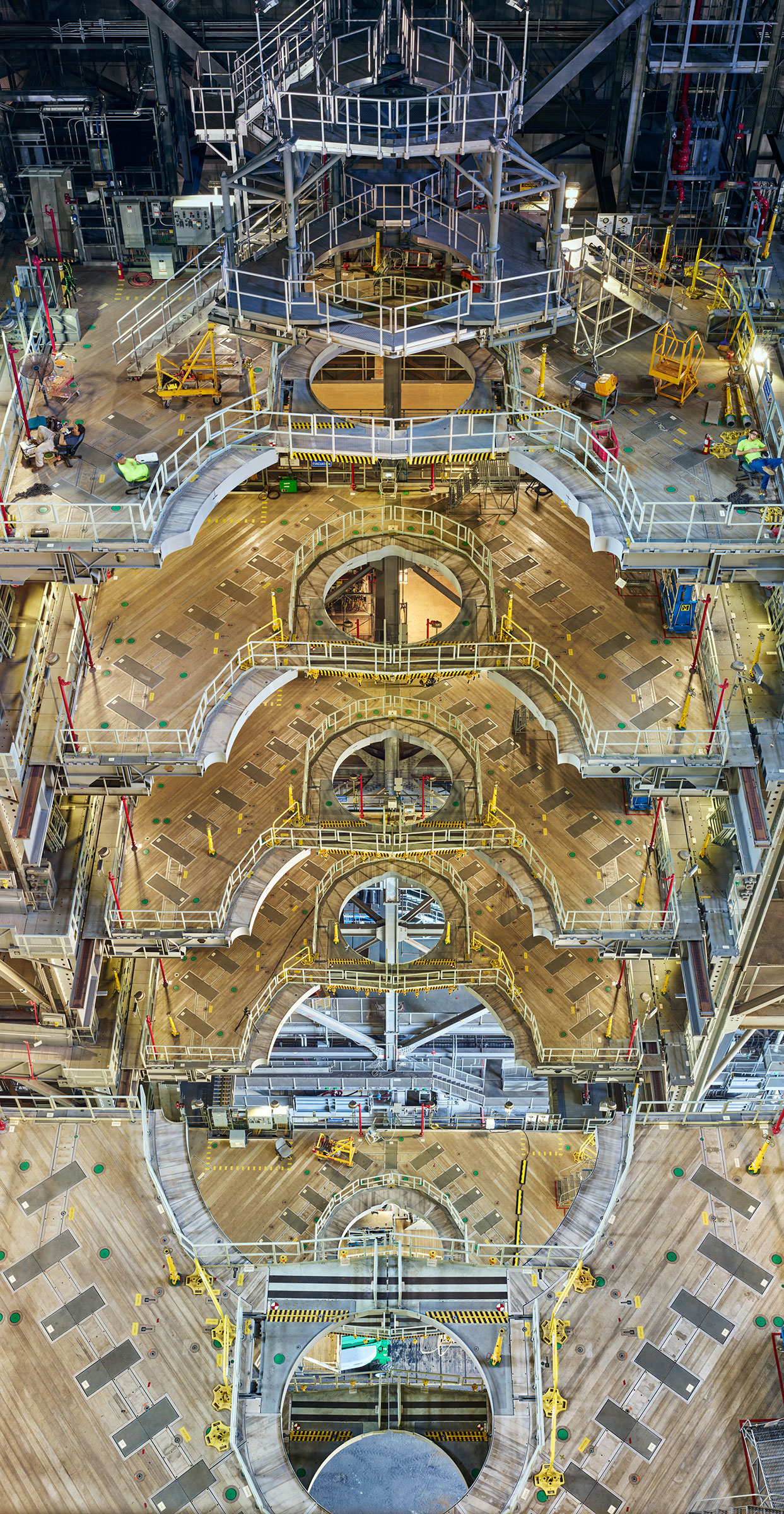
There are scientific and technological reasons to go to the moon too. Observatories on the lunar far side—shielded from earthshine and earthly radio emissions—would be more powerful and see farther than telescopes on the surface of the planet or orbiting it. And while NASA has been known to oversell the commercial spin-offs from the space program (“Off the Earth, for the Earth” is one of the agency’s slogans, by now shopworn), there’s no denying the decades of evidence that technology first developed for space travel often has terrestrial applications: scratchproof glass; lightweight, high-storage batteries that make cordless tools possible; memory foam and fireproof fabric; and, most significantly, GPS navigation all had their origins in systems designed for exploring space.
Future benefits could include applications in artificial intelligence, biometric sensors and air-traffic control, as well as crop fertilizers and greenhouse LEDs adapted from systems now in development for establishing otherworldly agriculture.
Then, too, there is the fact that any road to Mars likely runs straight through the moon. Homesteading a world that is only three days from Earth is the best way to test the life-support infrastructure that would be needed on a far more distant—and a good deal less barren—Mars.
All the lunar competitors are eyeballing the same spot on the surface: the south pole, which is as close to a fertile crescent as exists on the moon. The southern craters, cast in permanent shadow, are home to plentiful deposits of water ice, which could be used to sustain humans and their crops. The water can be broken down into oxygen, which can then be used as atmosphere for crews, and hydrogen, which—recombined with the oxygen—can make a simple, powerful and clean rocket fuel. Wrestling water and rocket fuel off Earth for a deep-space mission is a lot harder and more labor-intensive than carrying it up from the moon, where the gravity is one-sixth that of Earth, and then parking it in lunar orbit. Spacecraft on their way to Mars could, in theory, stop by the moon to top off their tanks before lighting out for deeper space.
None of that is outside the reach of current technology, but since the final Apollo lunar mission returned home in 1972, NASA’s crewed space program has pursued much narrower goals, contenting itself with dog paddling in low Earth orbit. And since the final NASA space shuttle stood down in 2011, the U.S. has not even had its own way to get astronauts into space, instead buying seats—at a cool $80 million per round trip—aboard Russia’s Soyuz spacecraft.
Now, though, there is a renewed focus on lunar dominance. In March, Vice President Mike Pence, the head of the newly re-established National Space Council (it had been disbanded since 1993), announced that the Trump Administration would put Americans on the moon by 2024. “It is the stated policy of this Administration and the United States of America to return American astronauts to the moon within the next five years,” he said at a council meeting in Huntsville, Ala. “‘Urgency’ must be our watchword.”
The timing for such a challenge was good because Florida’s Space Coast is once again buzzing with activity. NASA leased Cape Canaveral’s launchpad 39A, from which nearly all of the Apollo lunar missions took off, to SpaceX, which has plans for a crewed flight around the moon as early as 2023. “I can’t believe we get to use that pad,” says Musk. “We’re not worthy! This pad is too good.”
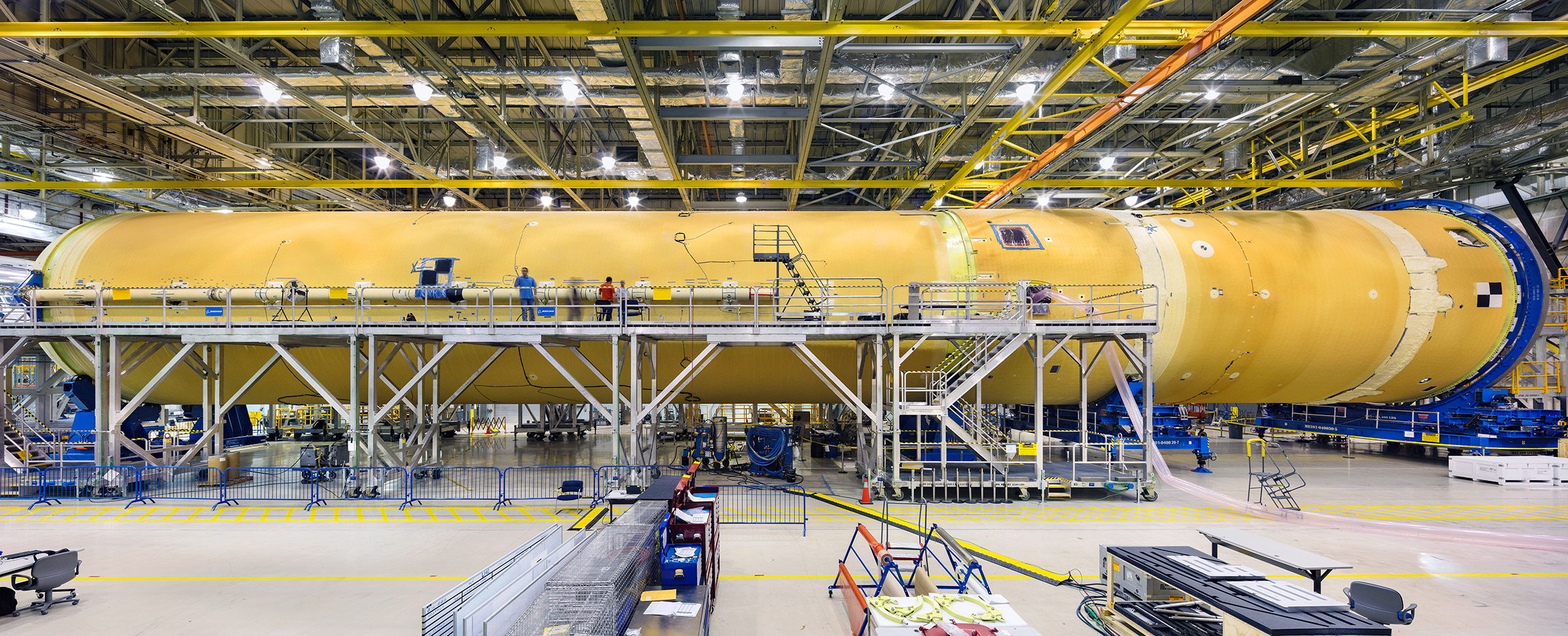
The company also holds the lease on nearby pad 40 and has built a 54,000-sq.-ft. hangar on the Canaveral grounds for rocket processing. Its Hawthorne, Calif., factory teems with workers and clangs with machinery under construction, including two Dragon spacecraft being readied in a clean room, one to test the ship’s escape system, the other for an automated flight to the International Space Station. But SpaceX envisions much more. “We really want to have a vehicle that is capable of sending enough payload to the moon such that we could have a full lunar base, like we’ve got a permanently occupied base in Antarctica,” Musk says. “[But] it’d be absolutely way cooler to have a science base on the moon.”
Similarly, NASA has leased Canaveral’s launchpads 36 and 11 to Blue Origin, the rocket company owned by Amazon CEO Jeff Bezos. Blue Origin has built a glittering $200 million factory on the Canaveral grounds and is planning a 90-acre expansion. In May, Bezos unveiled a mock-up of the company’s Blue Moon lunar lander and echoed the Trump Administration’s 2024 target date. “‘It’s time to go back to the moon,” he told a crowd in Washington, D.C., “this time to stay.”
NASA itself is stirring anew, its partnerships with private companies begun under the Obama Administration now bearing all manner of fruit. SpaceX and Virginia-based Orbital Sciences have made frequent uncrewed cargo runs to the International Space Station, and both Boeing and SpaceX hope to fly crews as early as next year. United Launch Alliance, a partnership of Lockheed Martin and Boeing, may supply the upper stage of the new rocket NASA hopes to use to send astronauts on the 2024 lunar trip.

Meanwhile, on Canaveral’s launchpad 39B, NASA has erected a $500 million, 10.5 million-lb., 38-story mobile launch tower that will service that new rocket: the giant Space Launch System (SLS)—NASA’s 21st century version of Apollo’s Saturn 5 moon rocket. Since Pence’s announcement, NASA has accelerated the timelines for SLS launches and the completion of the Orion crew vehicle—the modern analogue of the Apollo orbiter—as well as soliciting bids for a new lunar lander.
NASA is calling the latest lunar push the Artemis program, named after the mythical sister of Apollo. It’s all, deliberately or not, an echo of President Kennedy’s 1962 promise to have American astronauts on the surface of the moon by the end of the 1960s—a hard target and a fixed date that he challenged the country to meet. If Artemis succeeds, it will re-establish American primacy in space and prove that a riven country can once again do great things. If it fails, the U.S. will cede the moon, and its potential, for what could be decades to come.
The China National Space Administration (CNSA) caught the world napping. The People’s Republic didn’t launch its first satellite until 1970 and for decades was a space backwater. But in 2003, that started changing when China launched its first taikonaut—the Chinese equivalent of the American astronaut and the Russian cosmonaut. China has now flown multiple crewed missions, conducted spacewalks, and built and launched a mini space station. The country has also flown four robotic lunar missions, most spectacularly earlier this year, with the landing of the Chang’e-4 base station and rover on the far side of the moon.
Beijing has been explicit about the country’s plans for a south-pole lunar base—Chang’e-4 landed within what would be the Antarctic Circle on Earth. The CNSA has not officially disclosed whether a future base would be crewed or robotic, but as recently as 2017, Xinhua, the official state news agency, reported that Yang Liwei—the country’s first taikonaut—announced that China was indeed “making plans for a manned lunar landing.” Yang is to China what Neil Armstrong is to the U.S. and Yuri Gagarin is to Russia, and if he were speaking out of turn, Beijing would surely not let so influential a voice go uncontradicted.
But some observers in the West are incredulous. “When we’re dealing with the Chinese space program, the only thing we can rely on are the government’s periodic white papers and the Party Congress reports,” says Dean Cheng, senior research fellow for Chinese political and security affairs at the Heritage Foundation, a D.C. think tank. “Their last white paper, in 2016, did not mention a manned lunar program.”
China also says nothing at all about its space expenditures—or at least nothing remotely believable. The figure most widely cited in the press for the annual CNSA budget is $8 billion, or about 40% of NASA’s projected $20 billion. But most experts dismiss this figure as an almost laughable lowball. “[China’s] space program is embedded in their military,” says Cheng. “The defense-budget figure is generally cited as about $250 billion. It’s a polite fiction.” In truth, he argues, China likely spends vastly more on both defense and space, and its infrastructure shows it: “If they can sustain four different launch sites and two state-run [space-related] corporations with 90,000 employees, we should just pack it in if they’re doing it on $8 billion.”
NASA, by comparison, gets by on relative pan scrapings. The agency’s funding peaked in 1966, at just over $5.9 billion, the equivalent of $47 billion in 2019 dollars—more than twice what NASA gets today. After Pence announced the 2024 target for a return to the moon, the Trump Administration requested an additional $1.6 billion outlay, a figure not yet approved by Congress. Even if it were, it would still be well short of the $5 billion annual supplement many insiders believe is needed to make a 2024 moon landing happen. But the public buy-in for such a funding commitment just isn’t there. “We could fly more often with more funding if the nation wanted to fly more often,” says Orion program manager Mark Kirasich.
If China has a lead in finance and government commitment, however, by all appearances it’s far behind the U.S. in rocketry know-how. Getting to the moon begins with the problem of figuring out a way to get very heavy machines to move very fast. The Apollo era’s orbiter and lunar lander together weighed about 96,500 lb. That required building the massive Saturn 5 rocket, a leviathan that stood 363 ft. tall and generated a thrust of 7.6 million lb. For the more ambitious missions of the 21st century, NASA is designing the SLS to generate 8.8 million lb. of thrust. The additional muscle is key to getting the permanent infrastructure of the Artemis program off the ground. The plan is first to launch a mini space station, known as Gateway, into a near-lunar orbit. Crews of four astronauts would then fly an Orion out to Gateway, dock with it and take a lander down to the surface.

“This time when we go to the moon … we’re going to go sustainably,” says NASA administrator Jim Bridenstine. “We’re going to learn how to live and work on another world so that we can eventually go to Mars.” Initially, Gateway will make the Artemis missions more difficult and expensive than the Apollo missions, but in the long run it may be as affordable or cheaper. That’s because Orion is reusable. The lunar lander would be as well—at least partly. Like the original Apollo lunar module, the new version will be a two-part vehicle—a descent and ascent stage stacked one on the other. They land on the surface together, and when it’s time to leave, the ascent stage blasts off with the crew, leaving the descent half behind. That ascent stage could then be used again.
Like the International Space Station, Gateway will be expandable, with multiple docking ports for international or private partners to attach modules to conduct experiments and stage lunar landings. Gateway will fly what’s known as a near-rectilinear halo orbit, a series of elliptical circuits that can be adjusted with a relative puff of propellant, opening all parts of the moon to landing and exploration. Want to land at the south pole? Nudge your orbit one way. Want to land in the north? Nudge it the other. The Apollo spacecraft were locked in tight equatorial orbits, limiting potential landing areas.
First, though, NASA needs its rocket, and the SLS has been in start-stop development since 2005, with flat funding leading to repeatedly missed deadlines. Earlier this year, the Government Accountability Office issued a report finding that the SLS, the Orion and related systems have cost about $16 billion so far, some $1.8 billion more than was planned, largely thanks to delays. Now, however, the space agency insists the SLS is almost ready, and has an ambitious schedule, with the first crewed mission for around the moon planned for 2023.
Musk has moved more quickly still. The SpaceX Dragon, he says, may be ready to take a crew of astronauts to the ISS within the next six months. And though SpaceX’s biggest rocket, the Falcon Heavy, does not have the propulsive power of the SLS, at more than 5 million lb. of thrust, it’s the most powerful currently flying. In late June, SpaceX announced that as early as 2021, it will launch the Falcon Super Heavy rocket—with 10.8 million lb. of thrust—topped by a stainless steel, -180-ft. orbiter called Starship, with room for 100 passengers. That’s 17 times the size of the Orion, which has room for four to six astronauts. It’s the Super Heavy, not the existing Falcons, Musk believes, that will get humans past the “flags-and-footprints” model of the Apollo era and toward a more permanent presence on the moon and, later, Mars.
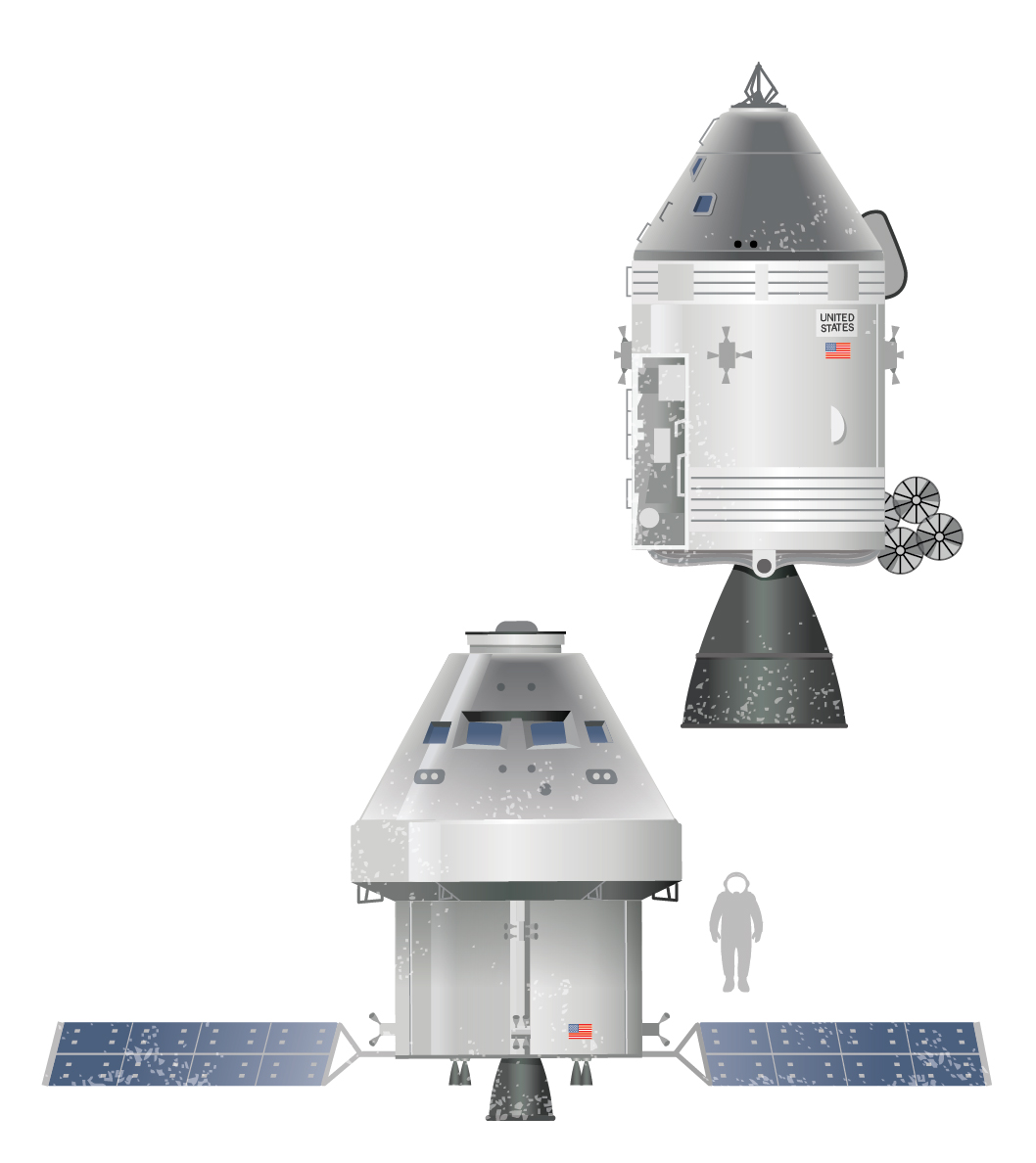
“We could sort of do a repeat of Apollo 11, a few small missions [with the Falcon Heavy], but the remake’s never as good as the original,” he says. Musk has already sold a handful of round-trip tickets to the moon aboard a future Starship, to Japanese fashion billionaire Yusaku Maezawa.
While Musk makes no secret at all of his plans, Bezos and Blue Origin’s are, at the moment, more of a mystery. The company’s main building and factory in Kent, Wash., could just as easily be one of Bezos’ Amazon fulfillment centers—though it’s not without a certain wit. There is a planter in the lobby that, on closer examination, turns out to be an engine bell used on an actual rocket; a huge model of the U.S.S. Enterprise just off the factory floor; and a spacecraft door from the Battlestar Galactica set propped up on display like a huge piece of sculptural art.
With its Amazon parentage, Blue Origin is not running short of funding anytime soon, but space programs are exceedingly expensive, with burn rates of billions before making any of that money back on paying customers, and there are only so many Prime shipments that can pay the freight. So at this point, says CEO Bob Smith, “there’s no question that our job at Blue at this phase of its life is to be a self-sustaining business.” The company’s primary goal is to become a launch-service provider, like SpaceX, and then to start flying paying customers to space.
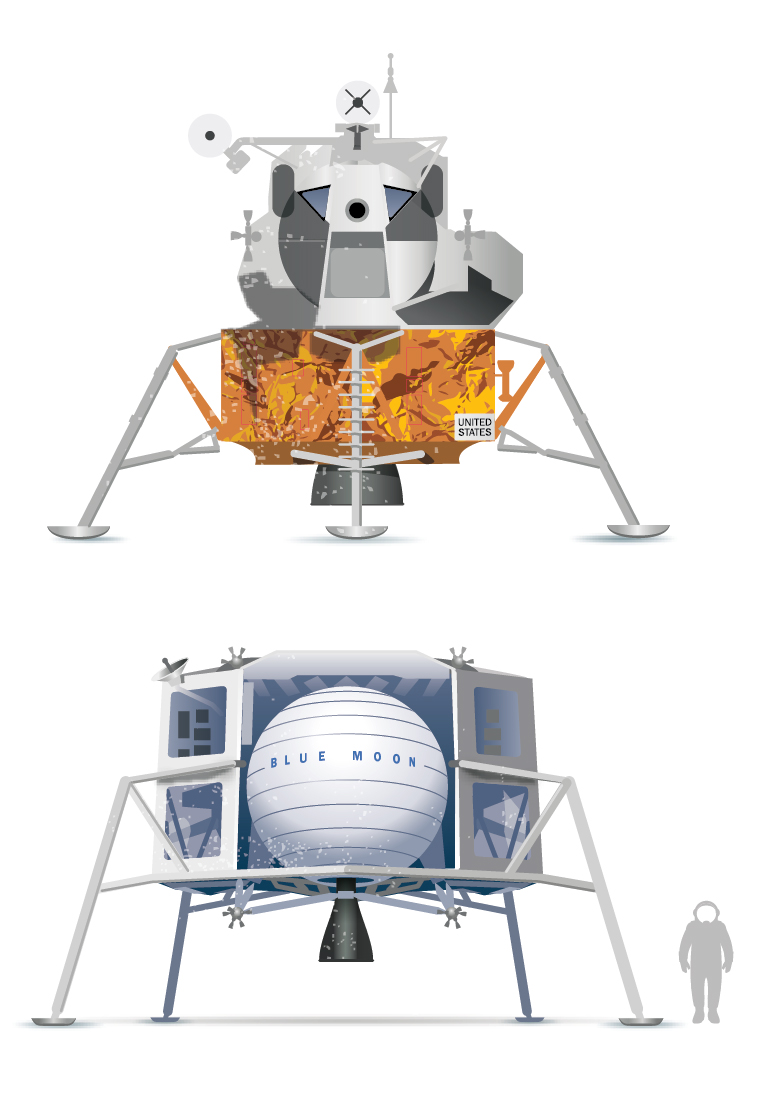
Blue Origin’s New Shepard rocket—named, like most of Blue’s vehicles, after U.S. space heroes, in this case Al Shepard, the first American in space—is fully reusable, designed to take payloads and people to suborbital space, for several minutes of zero G. That may seem like small-bore stuff: limited science and a vanity vacation for people with the money to afford it. But all of the hardware being developed for New Shepard is also intended for use on the much larger, soon-to-be-flying New Glenn rocket (after John, the first American to orbit Earth), the eventual New Armstrong (after Neil, the first person on the moon) and, most significantly, for Blue Moon, the company’s future lunar lander.
NASA has solicited bids for lunar landers from multiple companies for its Artemis program, but there’s no doubt that Blue Origin has a huge head start. “We don’t know what everyone else has until they actually give all their proposals out,” says Smith. “But we’ve been working on it for a while. We’ve gotten very good interactions with NASA … about what our thoughts are in terms of how we would go back to the moon by 2024.”
As for China, whatever its goal, the country’s crewed deep-space ambitions rely heavily on a new version of its Long March rocket series, called Long March 5. It has been poised to take a robot probe to and from the moon at the end of this year, and another mission to Mars in 2020. However, early development efforts haven’t gone smoothly. A 2016 test flight of the rocket more or less succeeded, with only a few trajectory problems on the way to orbit. But a 2017 launch failed, with the payload never reaching space. And a test planned for July of this year was postponed—a failure made public by European Space Agency satellite images, published online, showing the ships carrying the rocket idling at port well after they were supposed to have been en route.
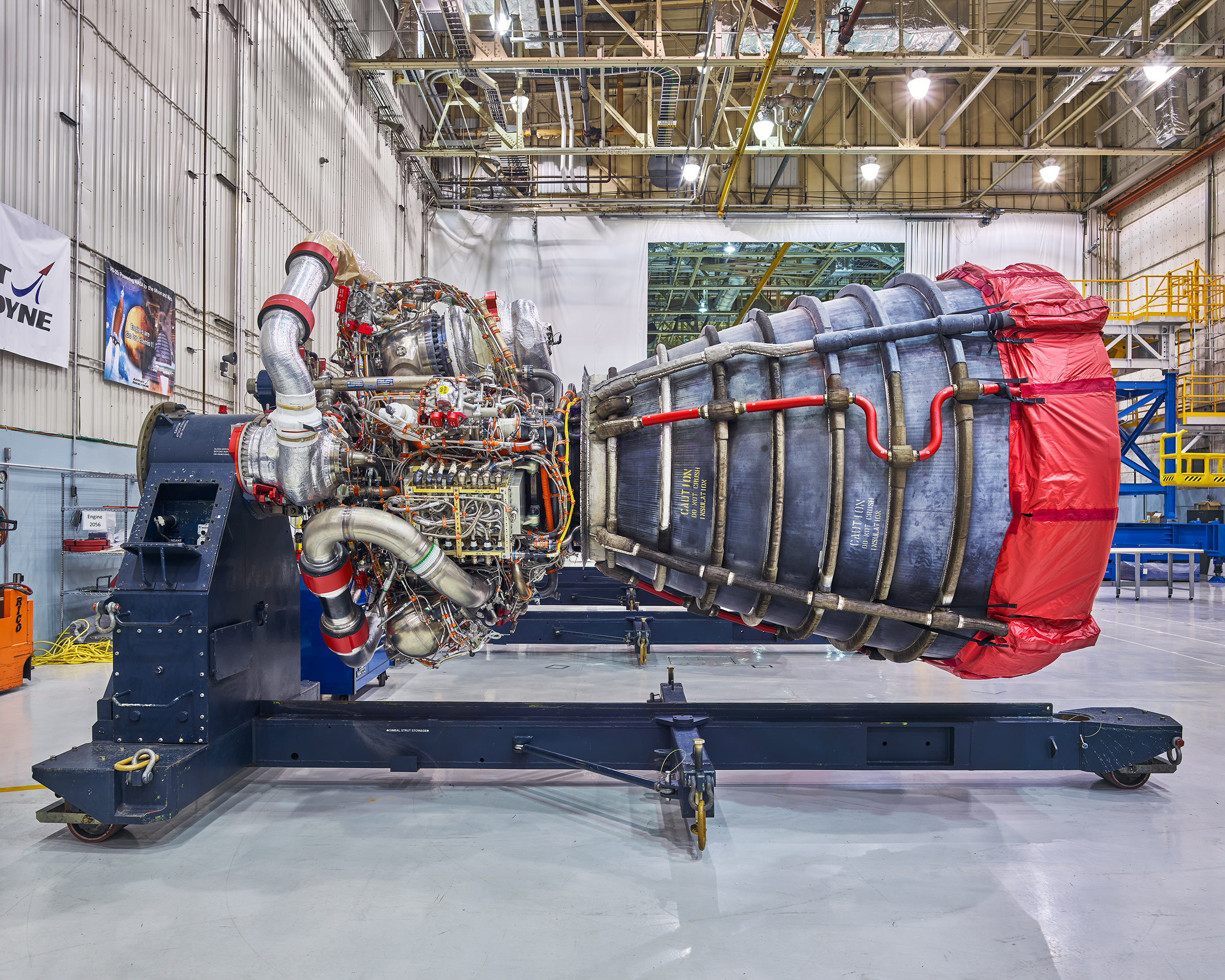
“This is really the first time the Chinese have had a significant slip in their space program,” says Cheng. “Sometimes they’ve had to stretch definitions or goals, [but] they haven’t had programmatic misses like the Long March 5.” And Long March 5 isn’t even the rocket that would take taikonauts to the moon. It’s a development phase intended to lead to the more powerful Long March 9. If China can’t get the 5 off the ground, it surely isn’t getting its bigger brother to fly.
There are also some questions about whether China’s moon plans are actually a tactical misdirection, a way to play the public relations game while focusing on less flashy but more practical research and security projects in Earth orbit. “China certainly isn’t racing the U.S. to the moon or anywhere else in space,” says Gregory Kulacki, the China project manager of the Union of Concerned Scientists, a U.S.-based science-advocacy nonprofit. “You can’t win a race you already lost 50 years ago.”
Of course, there doesn’t have to be a race at all, and international cooperation often works far better than competition. The U.S. has 15 partner nations working on the International Space Station. Russia, the European Space Agency, Japan and Canada have all contributed modules, and astronauts from 18 countries have flown aboard. With mounting tensions between the U.S. and Russia, space-station collaboration has been an effective pressure-release valve, especially when crews have to face problems together.

In 2015, a suspected ammonia leak in the American portion of the station required astronauts to hunker down in the Russian segment until the all-clear was sounded. Retired astronaut Terry Virts, who was aboard at the time, recalls that Dmitry Rogozin, then the Deputy Prime Minister in charge of defense and space industries, who had been involved in a heated exchange with D.C. over the invasion of Crimea, promptly radioed the station. “‘American colleagues,’” Virts recalls him saying, “‘you can stay as long as you want. We are going to work on this together.’”
In a world facing borderless threats like climate change and emerging diseases, that kind of cooperation will be increasingly important, and space is a good way to build trust. Collaboration between the American and Chinese space programs, however, is for now effectively prohibited by a 2011 spending-bill clause known as the Wolf Amendment, out of concern for technology transfers that could compromise national security. Technically, NASA could cooperate with China on civil projects that have no military applications, but practically, there is too much dual use in any space technology ever to clear that bar. And a space race with China, rather than a space partnership, has political utility in the U.S., in the same way the competition with the Soviet Union did 50 years ago. “[Former NASA administrator] Mike Griffin, Elon Musk and other U.S. space personalities routinely play on U.S. anxieties about China to get Congress to fork over more money,” says Kulacki. “Pence seems to be using the same playbook.”
Ultimately, playbooks and politics are—or at least ought to be—minor matters in the far larger mission to make human beings what they briefly were half a century ago: a species of two worlds. Michael Collins, command-module pilot for Apollo 11, remembers being especially struck by a refrain he heard over and over when he and the rest of the crew were on a world tour following the mission. “I thought that when we went someplace they’d say, ‘Well, congratulations. You Americans finally did it,’” he recalled in a recent interview. “And instead of that, unanimously the reaction was, ‘We did it. We humans finally left this planet.’”
- Introducing the 2024 TIME100 Next
- The Reinvention of J.D. Vance
- How to Survive Election Season Without Losing Your Mind
- Welcome to the Golden Age of Scams
- Did the Pandemic Break Our Brains?
- The Many Lives of Jack Antonoff
- 33 True Crime Documentaries That Shaped the Genre
- Why Gut Health Issues Are More Common in Women